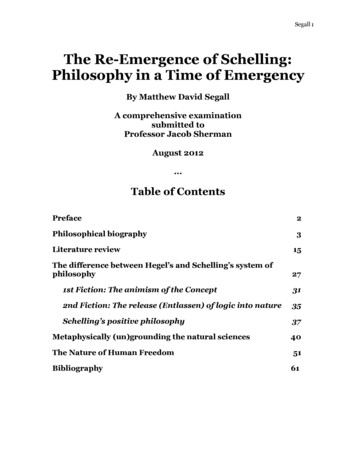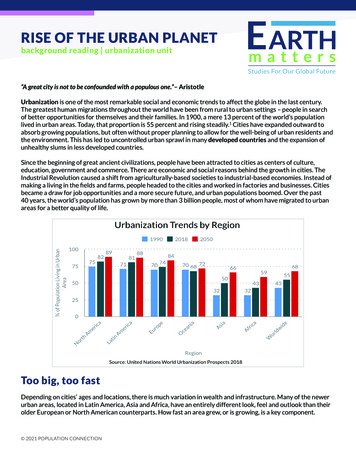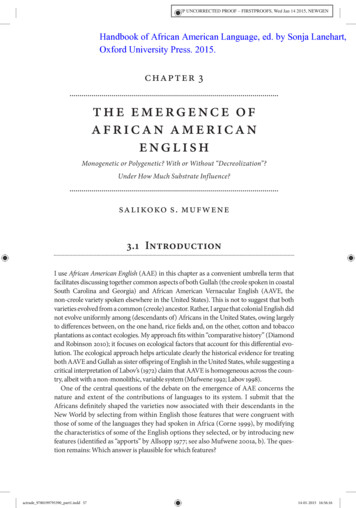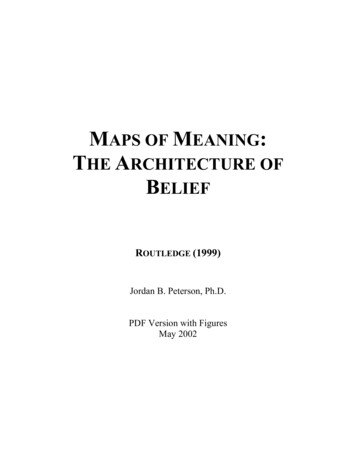
Transcription
Segall 1The Re-Emergence of Schelling:Philosophy in a Time of EmergencyBy Matthew David SegallA comprehensive examinationsubmitted toProfessor Jacob ShermanAugust 2012.Table of ContentsPreface2Philosophical biography3Literature review15The difference between Hegel’s and Schelling’s system ofphilosophy271st Fiction: The animism of the Concept312nd Fiction: The release (Entlassen) of logic into nature35Schelling’s positive philosophy37Metaphysically (un)grounding the natural sciencesThe Nature of Human FreedomBibliography405161
Segall 2PrefaceThe philosophy of Friedrich Wilhelm Joseph Schelling (1775-1854) cannot beadequately grasped in abstraction from the spirit that animated his individualpersonality. While he spent his philosophical career striving to realize the Absolutesystem, he did so in full recognition of the fact that the Absolute is not finally a logicalsystem, but a living actuality. 1 Accordingly, for Schelling, “life is the criterion of truth.” 2Though his critics often dismissed his thought as fragmentary and protean, C. S. Peirce,in a letter to William James, remarked that it was precisely Schelling’s “freedom fromthe trammels of system” and willingness to approach philosophical ideas experimentallyrather than dogmatically that he admired most: “In that, he is like a scientific man.” 3In the essay to follow, undertaken in the context of “a burgeoning Schellingrenaissance” 4 in the English-speaking world, as well as a planetary ecological emergencyand geo-political crisis, I return to Schelling’s written corpus to draw upon the deep wellof his thought in the hope that it can aid human civilization’s attempt to re-imagineitself. I believe his philosophy provides many of the anthropological, theological, andcosmological resources necessary for bringing forth alternative forms of modernity nolonger bent on the destruction of earth and the disintegration of human communities.I explore Schelling’s corpus for traces of the spirit that lived in his thoughts, beingcareful not to mistake the letter for the life. “When this element of life is withdrawn,”1Marcia Sá Cavalcante Schuback, “The Work of Experience,” Schelling Now, 74.2Mason Richey and Markus Zisselberger, “Introduction,” Historical-Critical Introduction to the Philosophy of Mythology, xvi.Peirce to James, 28 January 1894; Joseph Esposito, Schelling’s Idealism and Philosophy of Nature (London: Bucknell UniversityPress, 1977), 203.34Jason Wirth, “Introduction,” Schelling Now, 9.
Segall 3wrote Schelling, “propositions die like fruit removed from the tree of life.” 5 Hecontinues:.the person is the world writ small.One who could write completely the historyof their own life would also have, in small epitome, concurrently grasped thehistory of the cosmos. 6Philosophy, for Schelling, though generated by the natural processes of the universeitself, is “throughout a work of freedom” and so “for each only what he has himself madeit.” 7 In philosophizing, the individual discovers within his or her own unique originalitythe creative life of the whole universe. Schelling’s personal biography, then, is notextraneous but essential to understanding his philosophical project.Philosophical biographySchelling was born in 1775 near Stuttgart, a descendent of preachers and churchofficials on both sides of his family as far back as records can be found. 8 His father,Joseph Friedrich Schelling (1732-1812) was a well-known scholar of theology andancient languages, and there is no doubt that the young Schelling benefited from hisfather’s extensive library and tutelage. 9 At age 8, Schelling was sent to live with his uncleNathanael Köstlin (1711-1790), the dean of a school in Nürtingen where Schelling was tostudy the classics. It was here that Schelling first met Friedrich Hölderlin (1770-1843),later his roommate at seminary in Tübingen, as well as the Pietist mystics Friedrich5Schelling, Ages of the World, ed. Wirth, 4.6Schelling, Ages of the World, ed. Wirth, 3.7Schellings sämtliche Werke, I/2, 11; Bruce Matthews, Schelling’s Organic Form of Philosophy, p. 199.8Robert Richards, The Romantic Conception of Life, 116; Matthews, Schelling’s Organic Form of Philosophy, 44.9Matthews, Schelling’s Organic Form of Philosophy, 41.
Segall 4Christoph Oetinger (1702-1782) and Philipp Matthäus Hahn (1739-1790), both regularvisitors to his uncle’s home. 10 Hahn in particular had a profound personal and spiritualinfluence upon Schelling’s philosophical outlook.Only two years after enrolling at Nürtingen, Schelling was sent home because he hadoutgrown the knowledge of his instructors, “[spending] most of his time in the companyof books and adults.” 11 By age 11, his father began letting him sit in on his seminarycourses at Bebenhausen. He thrived alongside 18-year-olds, learning four ancientlanguages and reading Plato and Aristotle in Greek and Leibniz in Latin before reaching14-years-old.In the spring of 1790, when Schelling was 15, his friend and spiritual mentor Hahnpassed away. Schelling wrote a eulogy on the occasion of his death, later becoming hisfirst publication when it was printed in a Stuttgart newspaper. 12 According to Schelling,the eulogy for Hahn was “the first poem [he] ever wrote in [his] life.” 13 The fourthstanza, foreshadowing Schelling’s own commitment to Naturphilosophie, 14 reads:Did he not dare to speak, with astute demeanorStill mortal, the forces of nature?Did his eyes not plunge through the cosmos and earth’s daleSearching and finding the purest trace of the deity? 1510Matthews, Schelling’s Organic Form of Philosophy, 233n4.11Matthews, Schelling’s Organic Form of Philosophy, 47.12Matthews, Schelling’s Organic Form of Philosophy, 238n55.134 April 1811 to G. H. Schubert; Matthews, Schelling’s Organic Form of Philosophy, 62.14Matthews, Schelling’s Organic Form of Philosophy, 58.15Matthews, Schelling’s Organic Form of Philosophy, 223.
Segall 5Later in the year, Schelling was granted special permission to enroll in seminary at theTübinger Stift. There he reunited with Hölderlin and met Georg Wilhelm FriedrichHegel (1770-1831) for the first time, both 5 years older than himself. As wind of thephilosophical revolution instigated by Immanuel Kant in Königsberg and the politicalrevolution occurring across the Rhine in France drifted into the Stift, the three friendsbecame increasingly intoxicated by new ideas, ideas their seminary professors struggledto domesticate by rendering them compatible with traditional theology. 16 Hahn’s lastingtheosophical influence kept Schelling from ever completely accepting the premises ofthe Enlightenment, but there is no doubt that the newly quickened powers of reason,science, and freedom were extremely attractive to him.Instead of succumbing to the mechanistic trends of the natural science of his age,Schelling was from the beginning committed to Hahn’s alchemical Naturphilosophie,wherein nature was understood to be the revealed body of a living God. Schellingrealized that traditional literalist belief had no place in the modern world, but ratherthan rejecting religion entirely, he betrays his Pietist upbringing in seeking to replacebelief with direct experiential knowledge of the divine life. Hahn called the experience ofthis knowledge the Zentralschua; Schelling, upon assimilating the philosophy of Fichte,would come to call it the intellectual intuition. 17The impact of Johann Gottlieb Fichte (1762-1814) on the teenage Schelling waspowerful, as indeed was the impact of Schelling on Fichte, 13-years his senior.Schelling’s first philosophical publication in the fall of 1794, aged 19, was Über dieMöglichkeit einer Form der Philosophie überhaupt (On the possibility of a form of16Richards, The Romantic Conception of Life, 118.17Matthews, Schelling’s Organic Form of Philosophy, 36-37, 66.
Segall 6philosophy in general). The essay engages directly with Fichte’s defense of the Kantiansystem in Begriff de Wissenschaftslehre (Concept of the science of knowledge),published only months earlier.18 Schelling sent the Form essay along with an admiringletter to Fichte, to which the latter replied encouragingly. Fichte also sent a new andimproved version of his science of knowledge entitled Grundlage der gesammtenWissenschaftslehre (Foundations of the Entire Science of Knowledge, 1795) toSchelling. Almost immediately, on Easter of 1795, Schelling published his Vom Ich alsPrinzip der Philosophie oder über das Unbedingte im menschlichen Wissen (On the egoas the principle of philosophy or on the unconditioned in human knowledge).The traditional reading would have it that Schelling was Fichte’s disciple during theearly years of their collaboration ( 1794-1799). 19 More recent scholarship suggests notonly that most of Schelling’s major philosophical commitments had already beenformed prior to his encounter with Fichte’s subjective idealism, 20 but that Schelling’searly essays substantially improved Fichte’s understanding of his own project. 21Hölderlin, who had graduated from the Stift two years earlier, visited Schelling shortlyafter the publication of On the ego in 1795. Having just attended Fichte’s lectures at theUniversity of Jena, he reportedly told Schelling: “Take it easy. You’ve gotten as far asFichte. I’ve heard him.” 22For the next several years, Schelling published essays on critical philosophy in thePhilosophisches Journal co-edited by Fichte, despite his growing dissatisfaction with18Richards, The Romantic Conception of Life, 120-121.19Norbert Guterman, “Introduction,” Schelling, On University Studies, ix.20Matthews, Schelling’s Organic Form of Philosophy, 138-139.21Dale Snow, Schelling and the End of Idealism, 42-43.22Gustav Leopold Plitt, Aus Schelling Leben, I:71; Richards, The Romantic Conception of Life, 122.
Segall 7the latter’s subjectivist approach. 23 In 1796, the famed handwritten document, latertitled “Das älteste Systemprogramm des deutschen Idealismus” (“Oldest SystematicProgram of German Idealism”), emerged out of conversations between Schelling,Hölderlin, and Hegel. 24 The document begins by affirming the Fichtean position on theabsolute freedom of the ego, but balances this one-sided idealism by calling for a newkind of physics compatible with our nature as moral creatures and a “sensuous religion”capable of delivering this physics to the people. Hegel would eventually come toabandon the more radical positions of the “Systematic Program” to become the officialphilosopher of the Prussian state, while Hölderlin began showing signs of insanity by1800. Schelling, it seems, was the only one of his friends to remain consistentlycommitted to the document’s major outlines.Stemming from discontent both with Hegel’s mechanically formulaicepistemological fundament and the poet’s [Hölderlin’s] surrender to madness,the vitality in Schelling’s thinking is the search to hold these opposites together intheir many permutations. 25Also in 1796, Schelling published Philosophische Briefe über Dogmatismus undKriticismus (Philosophical Letters on Criticism and Dogmatism), wherein he arguesexplicitly that transcendental idealism and Spinozist realism should be understood to becoordinate systems: the former tackles the absolute from a subjectivist perspective,leading to the annihilation of the object, while the latter attains the absolute objectivelythrough the dissolution of the subject. 26 Beginning in 1797 with his Ideen zu einer23Richards, The Romantic Conception of Life, 123.24Richards, The Romantic Conception of Life, 124.25Richey and Zisselberger, “Introduction,” Historical-Critical Introduction to the Philosophy of Mythology, xvii.26Frederick Beiser, German Idealism, 476-477.
Segall 8Philosophie der Natur (Ideas for a philosophy of nature), Schelling published a seriesof groundbreaking and influential tracts on Naturphilosophie. These essays were thechildren of a marriage between Schelling’s theosophical convictions regarding nature asthe self-externalization of God (Geistleiblichkeit27) and his intense study of recentadvances in the natural scientific study of astrophysics, electricity, magnetism,chemistry, physiology, and medicine. 28 “What we want,” writes Schelling in Ideas,is not that nature should coincide with the laws of our mind by chance.but thatshe herself, necessarily and originally, should not only express, but even realizethe laws of our mind. 29In 1798, after Goethe had met the 23-year-old Schelling and read an advanced copy ofhis latest treatise Von der Weltseele, eine Hypothese der höheren Physik zur Erklärungdes allgemeinen Organismus (On the world soul, a hypothesis of the higher physics forthe clarification of universal organicity), 30 he interceded on Schelling’s behalf to havehim appointed extraordinary professor of philosophy at the University of Jena. 31Fichte was not impressed. He sought to distinguish his own position from what heperceived to be Schelling’s new turn toward realism, publishing thinly veiled criticismsof Schelling in subsequent issues of Philosophisches Journal. 32 Shortly after the last ofSchelling’s tracts on Naturphilosophie, the Einleitung zu dem Entwurf eines Systemsder Naturphilosophie (Introduction to the sketch of a system of nature philosophy),27Glenn Magee, Hegel and the Hermetic Tradition, 81.28Richards, The Romantic Conception of Life, 125.29Schelling, Ideas for a Philosophy of Nature. Trans. Errol E. Harris and Peter Heath, 41.Selections of which have recently been translated into English by Iain Hamilton Grant in Collapse: Philosophical Research andDevelopment, Vol. VI (Falmouth: Urbanomic, 2010), 58-95.3031Richards, The Romantic Conception of Life, 148.32Beiser, German Idealism, 479.
Segall 9had appeared in 1799, the rift between Fichte and Schelling had risen fully to thesurface. The two began quarreling about a philosophical journal they’d been planning toco-edit. 33 Soon after, Fichte was forced to leave Jena due to the charge of atheism. 34Over the next few years, Fichte became increasingly dismissive of Schelling’sphilosophical project, condescendingly writing to Schelling in 1801 that if only he wouldconsider his own science of knowledge more deeply “[he] would in time enough correct[his] mistakes.” 35 By the fall of 1801, Schelling had decided to start the KritischesJournal der Philosophie (The Critical Journal of Philosophy) with Hegel instead ofFichte as co-editor, cementing their personal and professional split. 36 The two never metor spoke again after 1802. 37 Fichte died in Berlin on January 27th, 1814, Schelling’s 39thbirthday.Schelling’s circle of friends in Jena at the turn of the century included Goethe, Schiller,the Schlegel brothers, and Novalis. During this time he became very close to Wilhelm’swife, Caroline Schlegel (1763-1809).38 When she fell ill in May of 1800, she traveled withSchelling and her 15-year-old daughter Auguste to Bamberg to consult with doctors andsoak in the nearby natural spas.39 By July, Caroline had recovered, but her daughterAuguste had fallen ill with dysentery. On July 12th, she died.33Richards, The Romantic Conception of Life, 177-178.34Richards, The Romantic Conception of Life, 166.35Fichte to Schelling, 31 May 1801, Schelling, Briefe und Dokumente, 2:339; Richards, The Romantic Conception of Life, 178.36Richards, The Romantic Conception of Life, 178.37Michael G. Vater and David W. Wood, eds., The Philosophical Rupture Between Fichte and Schelling, 282.38Richards, The Romantic Conception of Life, 166.39Richards, The Romantic Conception of Life, 169-170.
Segall 10Auguste’s sudden death was devastating for the entire circle. Schelling fell into adepression, while Caroline became more attached to him than ever. By early 1801, shehad expressed her affection for him in a letter: “I love you, I revere you, no hour passesthat I do not think of you.” 40 Soon after, she revealed to her husband of five years thatSchelling was “the first and only love of my life.” 41 Wilhelm Schlegel handled the end ofhis marriage with grace and forbearance, even risking his own reputation to deflect andrefute criticisms made against Schelling in a popular literary magazine claiming that hismeddling in Auguste’s medical treatment had been the reason for her prematuredeath. 42 With the help of Goethe, Wilhelm and Caroline obtained a divorce in May of1803. 43 Caroline married Schelling in June.It was back in 1801, during his period of collaboration with Schelling ( 1800-1807),that Hegel published his first book, entitled Differenz des Fichte’schen undSchelling’schen Systems der Philosophie (The difference between the Fichtean andSchellingian systems of philosophy). The work shows how highly Hegel thought ofSchelling’s so-called “identity philosophy” at the time. 44 He argues in the preface thatSchelling’s Naturphilosophie can “recompense nature for the mishandling that itsuffered in Kant and Fichte’s systems” byCaroline Böhmer Schlegel to Schelling, February 1801, Caroline: Brief aus der Frühromantik, 2:42; Richards, The RomanticConception of Life, 168.40Caroline Böhmer Schlegel to Wilhelm Schlegel, 6 March 1801, Caroline: Brief aus der Frühromantik, 2:65; Richards, TheRomantic Conception of Life, 168.4142Richards, The Romantic Conception of Life, 174-175.43Richards, The Romantic Conception of Life, 176n159.44Christopher Lauer, The Suspension of Reason in Hegel and Schelling, 71-82.
Segall 11.[setting] Reason itself in harmony with nature, not by having Reason renounceitself or become an insipid imitator of nature, but by Reason recasting itself intonature out of its own inner strength. 45Only six years later, Hegel would publish his most famous book, Phänomenologie desGeistes (Phenomenology of Spirit, 1807), wherein he appears to dismiss the creative actof intellectual intuition he defended in the Differenz essay, claiming it produces only anabstract absolute akin to “the night in which all cows are black.” The nature of thedisagreement and eventual falling out between Schelling and Hegel is taken up in asubsequent section. 46Schelling worked with Hegel on the Kritisches Journal in Jena for two years beforeleaving for Wüzburg in 1803. 47 After a 3-year stint at the Catholic university there,where Schelling was initially popular but ended up making few friends among themembers of the school’s conservative administration,48 he was appointed to theAcademy of Sciences in Munich in 1806. In 1808, he was named the Secretary Generalof the Academy of Fine Arts, a position Schelling held until 1821.In 1809, while Schelling was working on Philosophische Untersuchungen über dasWesen der menschlichen Freiheit und die damit zusammenhängenden Gegenstände(Philosophical investigations into the essence of human freedom), Caroline contracteddysentery. In September, Caroline died “with an expression of cheerfulness and themost wonderfully peaceful look on her face,” according to Schelling. 49 Schelling45G. W. F. Hegel, Differenz des Fichte’schen und Schelling’schen Systems der Philosophie, trans. H.S. Harris and Walter Cerf, 83.46See section heading “The difference between Hegel’s and Schelling’s system of philosophy” below.47The two even roomed together for a time when Hegel first moved to Jena in 1801 (Magee, Hegel and the Hermetic Tradition, 79).48Richards, The Romantic Conception of Life, 197.Friedrich Schelling to Luise Gotter, 24 September 1809, Caroline: Briefe aus der Frühromantik, 2:570; Richards, The RomanticConception of Life, 198.49
Segall 12remarried 3-years later, but the shock of Caroline’s death darkened his philosophicaloutlook, making him fully conscious of the contingency and “deep indestructiblemelancholy of all life,” as he wrote in the Freedom essay. 50 Less than a month afterCaroline died, Schelling wrote in a letter:I now need friends who are not strangers to the real seriousness of pain and whofeel that the single right and happy state of the soul is the divine mourning inwhich all earthly pain is immersed. 51He would publish only once more in his lifetime, but Schelling nonetheless workedtirelessly on a number of significant projects. In the months following Caroline’s death,he composed several drafts of a dialogue entitled Clara oder Zusammenhang der Naturmit der Geisterwelt (Clara, or on nature’s connection to the spirit world). 52 In thiswork, a physician, whose “bottom up” 53 approach to the science of healing is derivedfrom Schelling’s own Naturphilosophie, attempts to coax Clara, who mourns the deathof a dear friend, back down to earthly life from the ethereal bliss her soul longs to unitewith. A priest offers a different but complementary approach, describing theinterdependent “living rotation” of body, soul, and spirit that prevents the dead fromsoaring entirely beyond earth:For only a few pass over so pure and free of any love for earthly life that they canbe absolved immediately.[to disappear] in God like a drop in the ocean.” 5450Schelling, Philosophical Investigations into the Essence of Human Freedom, trans. Jeff Love and Johannes Schmidt, 63.51Brief über den Tod Carolines vom 2. Oktober, 1809, ed. Johann Ludwig Döderlein; Wirth, “Introduction,” Ages of the World, x.52Wirth, The Conspiracy of Life, 29.53Schelling, Clara, trans. Fiona Steinkamp, 15.54Schelling, Clara, trans. Fiona Steinkamp, 35, 52, 59.
Segall 13Caroline’s ghost haunts the pages of this dialogue, as Schelling struggles to account forthe ultimate destiny of her once-occurrent personality within the infinite current of theone cosmic life. Unlike the philosophical propositions of philosophers past which, asdescribed by Hegel in his Phenomenology, dialectically survive death to be sublated inthe course of the Idea’s self-unfolding, Caroline’s spirit cannot be abstractly reduced to“a few short, uncompleted propositions on a piece of paper.” 55 Her death was forSchelling “a singular and absolute loss.” 56In December of 1810, with the damp air still abuzz after a violent thunderstorm,Schelling wrote in his journal that work on Die Weltalter (The Ages of the World) was“begun in earnest.” 57 The Ages of the World has been described as his magnum opus, a“self-composing cosmic poem” 58that dives straight into the darkness of thecosmotheandric mystery that would consume Schelling’s thought for the rest of his life.Despite several announcements of its imminent publication in the course of the next twodecades, the unfinished drafts were ultimately withheld until Schelling’s SämtlicheWerke was published by his son Karl in 1856, two years after his death. His latephilosophies of mythology and of revelation should be considered the fruits of insightsdeveloped in the course of the Weltalter project, which itself remains in many respectscontinuous with his early Naturphilosophie. In his lectures on the philosophy ofmythology, delivered in Berlin beginning in 1841, Schelling says of myth that it55Schelling, Ages of the World, ed. Wirth, 4.56Wirth, The Conspiracy of Life, 216.57Schelling, Die Stuttgarter Privatvorlesungen (1810), ed. Miklos Veto, 216; Wirth, “Introduction,” Ages of the World, vii.58Wirth, “Introduction,” Ages of the World, x.
Segall 14“indisputably has the closest link with nature,” and that modern explanations suffereddue to “a lack of natural philosophical ideas.” He goes on to argue that we must learn tosee mythology as a nature elevated into the spiritual realm through an enhancingrefraction. Only the means [have been] missing to make the enhancementconceivable. 59In other words, in these lectures, Schelling attempts to articulate the way myths “arisefrom the human soul’s prereflective immersion in the divine substance of the cosmos.” 60Rather than reducing myths to allegorical inventions of the human mind, Schellingargues that, in fact, it is the human mind that has been invented by myth.Though these lectures were initially “a kind of celebrity event” 61 attended by the likes ofKierkegaard, Engels, and Bakunin, their message, though influential in some respects, 62fell largely upon deaf ears. Those in attendance had been lead to expect Schelling wouldsharply rebuke the now deceased Hegel (quelling the radical Hegelians had been theintention of the state and university officials who called him to Berlin 63), but to theirdisappointment, Schelling sought healing, rather than polemic. 64The lukewarmreception of the lectures is a reflection of a change in the Zeitgeist. The philosophicalquickening which had inspired so many German minds around the turn of the century59Schelling, Historical-critical Introduction to the Philosophy of Mythology, trans, Wirth, 155-156.60Jerry Day, Voegelin, Schelling, and the Philosophy of Historical Existence, 72.61Wirth, “Introduction,” Historical-critical Introduction to the Philosophy of Mythology, viii.Kierkegaard’s debt to Schelling’s characterization of Hegel’s philosophy is well known. Emerson translated and published the firstof Schelling’s Berlin lectures in an issue of The Dial in January of 1843, writing in a letter to a friend at time: “To hear Schellingmight well tempt the firmest rooted philosopher from his home, and I confess to more curiosity in respect to his opinions than tothose of any living psychologist” (Norbert Guterman, “Introduction,” On University Studies, xix).6263Richards, The Romantic Conception of Life, 198.64Schelling, Historical-critical Introduction to the Philosophy of Mythology, trans. Wirth, viii.
Segall 15had by the 1840s all but dried up as Europe’s intelligentsia began to sink into thescientistic positivism that would dominate for the remainder of the century and beyond.Schelling retired into obscurity in 1846. In the summer of 1854, poor in health, hetraveled to Bad Ragaz, Switzerland to take the cure. His spirit left its 79-year-old bodyon August 20–a spirit, it seems, who was born too early. 65 “Perhaps the one is stillcoming,” writes Schelling in the introduction to the third draft of The Ages of the World,who will sing the greatest heroic poem, grasping in spirit something for which theseers of old were famous: what was, what is, what will be. But that time has notyet come. We must not misjudge our time. 66Literature reviewThis section assesses the reasons for the contemporary resurgence of scholarly interestin Schelling. At least since the 1990s, after more than a century and a half on the shelf,Schelling’s corpus has been re-emerging “with increasing intensity” in the Englishspeaking world.67 There are many reasons to reconsider Schelling’s philosophicaloeuvre, but the current resurgence in interest seems to orbit primarily around hisunique approach to the problem of nature, whether the nature of the cosmos, of thehuman, or of the divine.In his prized 1809 essay Philosophical Investigations into the Essence of HumanFreedom, Schelling writes:65Wirth, “Introduction,” Schelling Now, 5.66Schelling, Ages of the World, trans. Wirth, xl.67Wirth, “Schelling’s Contemporary Resurgence,” 585.
Segall 16The entire new European philosophy since its beginning (with Descartes) has thecommon defect that nature is not available for it and that it lacks a livingground. 68The non-existence of nature for thought in the modern period has had terribleconsequences for human history and the natural world alike. From Descartes through toKant, Fichte, and Hegel, reason and science became increasingly self-castrating andsolipsistic; “like the priests of the Phrygian goddess,” modern thought detached itselffrom the living forces of its natural ground. 69In his Philosophies of Nature After Schelling (2005), Iain Hamilton Grant articulatesthe scientific and metaphysical consequences of ignoring nature, arguing thatdeep geological time defeats a priori the prospect of [nature’s] appearancefor any finite phenomenologizing consciousness. 70In other words, while the Kantian turn in the philosophy of science drained nature ofontological significance by defining it phenomenologically as “the sum total of appearingbodies,” the empirico-mathematical study of nature nonetheless came to reveal worldages prior to the emergence of any consciousness for whom material nature could havemade an appearance. Further, contemporary physics has de-corporealized (and so dephenomenalized) matter in favor of a dynamic, field-theoretic understanding of naturalforces. Schelling’s Naturphilosophie not only foresaw and helped to initiate thesediscoveries, 71 it provides the new sciences of self-organizing systems with a more68Schelling, Philosophical Investigations Into the Essence of Human Freedom, trans. Jeff Love and Johannes Schmidt, 26.69Schelling, Philosophical Investigations Into the Essence of Human Freedom, trans. Love and Schmidt, 26.70Iain Hamilton Grant, Philosophies of Nature After Schelling, 6.71Consider, for example, Schelling’s influence on Hans Christian Ørsted’s discovery of electromagnetism in 1820.
Segall 17coherent and adequate metaphysical foundation than the old mechanistic atomism. 72Naturphilosophie’s principle aim is to articulate, in a systematic but non-reductive way,how it is possible that natural productivity (natura naturans), and not representationalconsciousness (cogito cogitans), is a priori. Grant suggests that Schelling was able tooverturn the Kantian Revolution, not by outright dismissing the primacy of practicalreason, but by literally grounding it in a “geology of morals” that transforms ethics intophysics. 73The relevance of Schelling’s Naturphilosophie to the metaphysicalfoundations of contemporary natural science will be taken up again in a subsequentsection. 74Some contemporary scholars, like Andrew Bowie in his Schelling and ModernEuropean Philosophy (1993), dismiss Schelling’s later mythopoeic and theogonicspeculations into the divinity of nature and the nature of divinity as “evidently dead,” 75while others, like Grant, simply ignore it. In The Dark Ground of Spirit: Schelling andthe Unconscious (2012), S. J. McGrath pays very close attentio
25 Richey and Zisselberger, “Introduction,” Historical-Critical Introduction to the Philosophy of Mythology, xvii. 26 Frederick Beiser, German Idealism , 476-477. Philosophie der Natur ( Ideas for a phil










